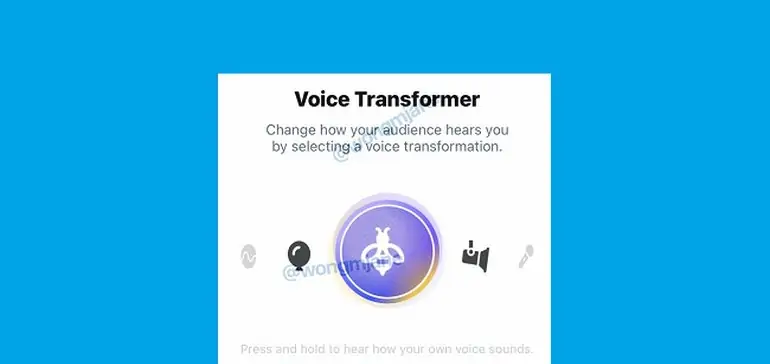Mobile App Development, SEO, Social Media, Uncategorized, Web Development, Website Design
Twitter’s Testing New Vocal Effects Options for Spaces, Which Could Help to Reduce Speaker Anxiety
- By Brett Belau
22 Jul

If you’re like everyone, you don’t particularly enjoy hearing your own voice in recordings and playback.
You always sound more nasal, higher-pitched – the voice you hear inside your head, which resonates around your bones and muscles, will always sound different to the one that you project. You just don’t know about it till you hear it played back, and that, for many, can be jarring, and can even make some hesitant to take part in interviews, or in more recent times, audio chats.
Which is where this might come in handy – Twitter is currently experimenting with a new set of voice-changing options for Twitter Spaces, which would enable you to filter your voice through a range of effects.
As you can see in this option, posted by reverse engineering expert Jane Manchun Wong, the new ‘Voice Transformer’ tool would provide a range of different vocal effect filters for you to change how you sound in the app.
Twitter’s Danny Singh later confirmed the test, and posted this example of the effects in action.
Some people won’t see any need for these tools, of course, but others may like having the ability to change how they sound, for various reasons, while it could also be handy for audio plays and dramatic readings, with the capacity for a single person to perform multiple characters, or to invite other readers into roles through the use of a specific filter.
That could open up new engagement options in Spaces, which is gaining traction among Twitter users, and is set to become a bigger focus for the app, with a dedicated tab on the way, and higher priority for Spaces via the top of timeline display.
Last week, Twitter announced that it would be retiring its Stories-like Fleets option next month, but the top of feed bubbles will remain, and will revert to highlighting Spaces exclusively. That, along with the tab, underlines the potential that Twitter sees in audio tools, and functional additions like this could help to expand inclusivity and boost user interest in the option.
It could also be used to disguise people in rooms, which may have unintended impacts, and it could additionally be used in a negative, bullying way. But it’s an interesting experiment, with significant potential value, and Twitter will likely launch a live test to get a measure on user response in the near future.
Audio tools are having something of a renaissance, with the rise of Clubhouse sparking a new wave of audio options in all the major apps, and TikTok making music and sound a key focus, shifting away from the traditional ‘audio off’ approach for most social apps. Facebook has also launched Soundmojis for Messenger, and is working on a new Soundbites option for sharing audio clips.
Given this, Twitter’s sound filters also align with that shift, and again, it could be a hugely valuable option that helps more users feel comfortable joining Spaces chats.
So, soon you won’t have to worry about sounding flat in Spaces – you can just add a megaphone voice filter and become Oz behind your own curtain. Or a bee. Or whatever you may choose.
It seems like an interesting addition – we’ll keep you updated on any progress.
Source: www.socialmediatoday.com, originally published on 2021-07-22 16:16:07
Connect with B2 Web Studios
Get B2 news, tips and the latest trends on web, mobile and digital marketing
- Appleton/Green Bay (HQ): (920) 358-0305
- Las Vegas, NV (Satellite): (702) 659-7809
- Email Us: [email protected]

© Copyright 2002 – 2022 B2 Web Studios, a division of B2 Computing LLC. All rights reserved. All logos trademarks of their respective owners. Privacy Policy

![How to Successfully Use Social Media: A Small Business Guide for Beginners [Infographic]](https://dev.b2webstudios.com/storage/2023/02/How-to-Successfully-Use-Social-Media-A-Small-Business-Guide-85x70.jpg)



![How to Successfully Use Social Media: A Small Business Guide for Beginners [Infographic]](https://dev.b2webstudios.com/storage/2023/02/How-to-Successfully-Use-Social-Media-A-Small-Business-Guide-300x169.jpg)


Recent Comments